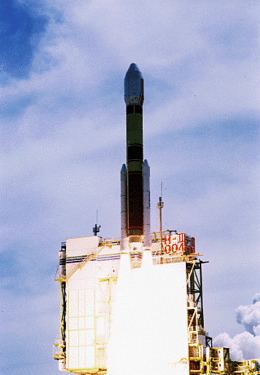COSPAR ID 1996-046A Launch mass 3,500 kg (7,700 lb) Rocket H-II | SATCAT № 24277 Launch date 17 August 1996 Last contact 30 June 1997 | |
 | ||
Names Advanced Earth Observing SatelliteMidori Mission type Earth observationEnvironmental monitoring Mission duration Final: 10 months, 13 days Operator National Space Development Agency of Japan Similar Glory (satellite), Essaim (satellite), Parasol (satellite) | ||
ADEOS I (Advanced Earth Observing Satellite 1) was an Earth observation satellite launched by NASDA in 1996. The mission's Japanese name, Midori, means "green".
Contents
The mission ended in July 1997 after the satellite sustained structural damage to the solar panel array. Its successor, ADEOS II, was launched in 2002. Like the first mission, it ended after less than a year – also following solar panel malfunctions.
Iridium 86 and adeos ii flares avi
Purpose
ADEOS was designed to observe Earth's environmental changes, focusing on global warming, depletion of the ozone layer, and deforestation.
On board the satellite are eight instruments developed by NASDA, NASA, and CNES. The Ocean Color and Temperature Scanner (OCTS) is a whisk broom radiometer developed by NASDA. The Advanced Visible and Near Infrared Radiometer (AVNIR), an optoelectronic scanning radiometer with CCD detectors, was also produced by NASDA. The NASA Scatterometer (NSCAT), developed with the Jet Propulsion Laboratory, used fan-beam Doppler signals to measure wind speeds over bodies of water. The Total Ozone Mapping Spectrometer (TOMS) was built by CNES to study changes to Earth's ozone layer. The Polarization and Directionality of the Earth's Reflectance (POLDER) device was also developed by CNES, and was also launched on ADEOS II. The Improved Limb Atmospheric Spectrometer (ILAS) was developed by NASDA and the Environment Agency of Japan, and used grating spectrometers to measure the properties of trace gases using solar occultation. The Retroreflector in Space (RIS) and Interferometric Monitor for Greenhouse Gases (IMG) were both developed by Japan, and studied atmospheric trace gases and greenhouse gases respectively.
Failure
On 28 August 1996, the satellite adjusted its attitude to control its orbit. As a result of this maneuver, the solar panel received sunlight from the rear. This caused the solar paddle mast to expand and the panel blanket to contract, placing tension on a soldered joint on the paddle, which eventually broke.
The final communication from the satellite was received at 07:21 UTC on 30 June 1997, 9 months after launch.
